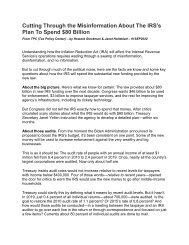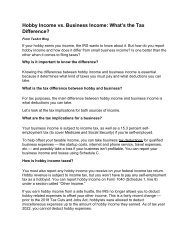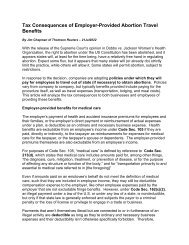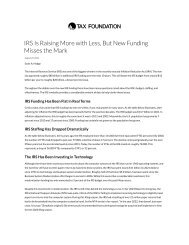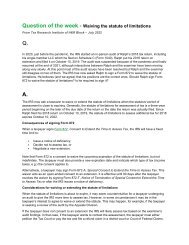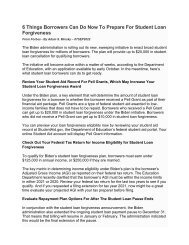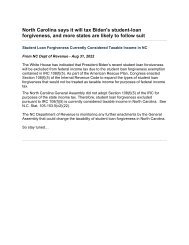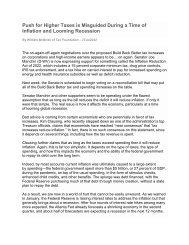Want To Buy US Citizenship
You also want an ePaper? Increase the reach of your titles
YUMPU automatically turns print PDFs into web optimized ePapers that Google loves.
<strong>Want</strong> <strong>To</strong> <strong>Buy</strong> U.S. <strong>Citizenship</strong>? For<br />
Foreign Investors, It Now Costs A Cool<br />
$1.05 Million<br />
From Forbes – by Jeremy Babener – 07Sep2022<br />
Wealthy foreigners have had special access to U.S. citizenship since 1990.<br />
For $900,000, then $1.8 million, and now $1.05 million, the EB-5 Visa<br />
program has offered a 2-year path to citizenship. Over the last 14 months, the<br />
path has changed, disappeared, and reappeared in different forms.<br />
Uncertainty has stalled visa applications and large commercial projects. But<br />
with passage of legislation in March, 2022, and upcoming regulations by U.S.<br />
<strong>Citizenship</strong> and Immigration Services (“UCSIS”), much of the path is now<br />
clear again. This article provides a short history of the EB-5 program, recounts<br />
key events from the last 14 months of chaos, and walks through the rules to<br />
know going forward.<br />
The Basics of EB-5<br />
U.S. <strong>Citizenship</strong> and Immigration Services (<strong>US</strong>CIS) establishes rules for the EB-5<br />
program<br />
GETTY IMAGES<br />
As UCSIS puts it, Congress created the EB-5 path to citizenship to “benefit<br />
the U.S. economy by providing an incentive for foreign capital investment that<br />
creates or preserves U.S. jobs.” It’s the fifth “employment-based” path to<br />
permanent residency after those for (1) priority workers, (2) professionals<br />
holding advanced degrees, (3) skilled workers, and (4) “certain special<br />
immigrants.” Before 1990, a foreign investor who couldn’t meet those criteria<br />
had limited options, even if wealthy.<br />
Those granted an EB-5 visa receive conditional permanent resident status for<br />
a 2-year period (i.e., a “green card”). After two years of compliance with the<br />
requirements (discussed below), permanent residence is pretty much<br />
guaranteed. The same benefits apply for one’s immediate family members.<br />
In 1992, Congress authorized the use of “Regional Centers,” allowing foreign<br />
investors to pool investments in a single (though typically larger) enterprise<br />
that satisfies the EB-5 requirements for multiple investors. As of the end of
2021, over 632 Regional Centers have been authorized to accept EB-5<br />
investments.<br />
Who and How Many?<br />
The EB-5 program is limited by statute to 10,000 visas annually. In 2019, of<br />
the 9,478 EB-5 visas, UCSIS granted 77% of visas to investors from Asia.<br />
96% of visas granted were based on investment in a Regional Center.<br />
Foreigners have invested over $40 billion in U.S. businesses through the EB-5<br />
program. In 2019 alone, EB-5 applicants invested over $5 billion.<br />
A Recent End to Uncertainty<br />
Three events in the last 14 months upended the EB-5 process and<br />
community.<br />
On June 22, 2021, a federal district court in California invalidated regulations<br />
from 2017 governing the EB-5 program. Among other things, the regulations<br />
had doubled the standard investment threshold from $900,000 to $1.8 million.<br />
The court held that the regulations were improperly created and effectively<br />
revoked them.<br />
One week later, on June 30, 2021, the statutory authorization for Regional<br />
Centers expired. This has occurred several times before, and each time<br />
creates significant uncertainty for all involved. Without authorization, Regional<br />
Centers cannot support new EB-5 visas.<br />
The expiration was partly cured this March with the enactment of the EB-5<br />
Reform and Integrity Act of 2022. The law re-authorized use of Regional<br />
Centers through 2027, but also surprised many by repealing the previous<br />
statutory authorization. As a result, <strong>US</strong>CIS announced that “regional centers<br />
previously designated…are no longer authorized” and must seek<br />
redesignation. Business associations focused on the EB–5 program<br />
have expressed concerns and at least one regional center has sued.<br />
Evolving Eligibility<br />
Eligibility for an EB-5 visa requires that a foreigner make (1) an at-risk<br />
investment of (2) a threshold amount (3) of legally obtained funds in (4) a new<br />
U.S. business in which (5) the foreigner actively participates and that (6)
creates at least 10 jobs. Requirements 3, 4, and 5 are usually easy to satisfy,<br />
and 6 much more so when an investment is made through a Regional Center.<br />
1. At-Risk Investment. The foreigner’s invested capital must be placed at<br />
risk. Thus, she must make an equity investment, not a loan, personal<br />
guarantee, or promise to pay. While she can place funds in escrow pending<br />
visa approval, those funds cannot be kept separate past approval.<br />
Investments in Regional Centers are subjected additional rules. For example,<br />
to ensure that funds invested in a Regional Center are creating jobs, they only<br />
count toward investment eligibility thresholds if they’re held by the entities<br />
closest to the job creation. Thus, funds aren’t counted if held and used by a<br />
holding company (e.g., to satisfy start-up and administrative expenses,<br />
including attorney fees, administrative fees, and rent).<br />
2. Threshold Amount. The standard threshold investment is $1.05 million,<br />
increased from the original threshold of $900,000, and decreased from its<br />
height of $1.8 million under regulations invalidated last year.<br />
The threshold investment is reduced for “rural” and “targeted employment<br />
areas.” As of this March, the new threshold is $800,000, increased from the<br />
original threshold of $500,000, and decreased from its height of $900,000.<br />
3. Legally Obtained Funds. This requirement is self-evident. Notably, <strong>US</strong>CIS<br />
may and often does request evidence to demonstrate the source of funds.<br />
Greater burdens of proof apply for funds from Iran and other countries of<br />
concern.<br />
4. New Business. In fact, the reference to “new business” is highly<br />
misleading. Since 2009, foreigners have been able to invest in existing<br />
businesses. That is, unless the existing business was formed before 1990.<br />
Even then, investing in an existing business is permitted under common<br />
circumstances.<br />
5. Active Involvement. Though not stated by legislation, <strong>US</strong>CIS rules hold<br />
that a “purely passive” investment is insufficient. However, those rules also<br />
reference the sufficiency of policy formulation. In fact, according to the <strong>US</strong>CIS<br />
Policy Manual, it’s enough for an investor to have the minimal rights, powers,<br />
and duties typical of a limited partner.<br />
6. Job Creation. The target business must create 10 full-time jobs for 2.5<br />
years after the visa is granted. <strong>To</strong> demonstrate that this will happen, a
foreigner’s visa application must include a business plan showing how the job<br />
creation requirement will be met (e.g., market analysis, competitor<br />
comparisons, financial projections).<br />
This is by far the most difficult hurdle of the program. Says business advisor<br />
and tax lawyer Roberto Santos, “The business plan needs to hit all the criteria<br />
they’re looking for. Preparing a good application is very much about process.”<br />
Satisfying the job creation requirement is made far easier by investing through<br />
a Regional Center. In doing so, investors are permitted to count both direct<br />
and indirect jobs. That is, jobs created by a Regional Center’s suppliers and<br />
service providers are counted, whether or not they’re in the targeted<br />
geographic area. The job creation requirement is also significantly reduced for<br />
failing target businesses, though that’s typically far less attractive to<br />
immigrating investors.<br />
Looking Forward<br />
The last 14 months created great uncertainty for EB-5 applicants and wouldbe<br />
Regional Centers. But after the legislation passed in March, and with<br />
upcoming regulations, we now have significant clarity on the critical eligibility<br />
requirements of the program. No doubt we’ll see more and more immigrants<br />
interested in using this path to citizenship.<br />
Notably, a leading immigration treatise observes that the U.S. tax structure is<br />
the “main disincentive” to use of the program. This separate article discusses<br />
how some foreign investors mitigate the impact of becoming subject to<br />
worldwide taxation.



